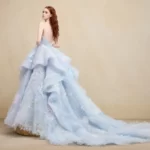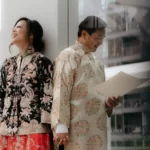We’ve all been stuck with them or, at the very least, know someone who has a closet full of stiff taffeta bridesmaid gowns with big sleeves.
Today’s trends should be a relief to any bridesmaid in waiting. The fabric choices are softer, the styles are contemporary and a wide range of colours are available. Best of all, the bridesmaids’ dresses in a wedding party don’t even have to be identical.
Here’s what’s happening:
- Body-skimming dresses that are sexy and wearable after the wedding.
- Elegant two-piece dresses that offer more options after the wedding.
- Barely-there tops with straps.
- Various skirt lengths: floor-length, short, handkerchief hemlines or short in the front and long in the back.
Individual options
There are a multitude of ways to have a co-ordinated style that is appropriate for different body types.
A specific fabric and gown length can be chosen, and then each bridesmaid could choose the dress shape that flatters her body type. For example, a woman with thin or large arms may prefer an elbow-length cape sleeve. Another woman may choose a short cap sleeve, and a third may want a sleeveless dress.
There may be concerns about the neckline. One attendant may want a high neckline, another may want square, and another a V-neck. These options allow individuality without interfering with the overall style of the wedding party.
One bride wrote us to say that she asked each attendant to wear any black dress of her choice with black sheer pantyhose and black sandals. She then provided each of them with an oversized satin scarf in shocking pink, which they could wear any way they wanted. One chose to wear the scarf around her hips. One wore it was a shawl. Another wound it around her hair.
The bride wore a lone, white sheath and carried a small bouquet that included the same bright pink of the bridesmaids’ scarves. She also wore pink flowers in her hair.
The bottom line is there are lots of options. Identical dresses are still a good option if all the attendants can agree. If there are major differences in style and figure types, however, consider alternate possibilities.







